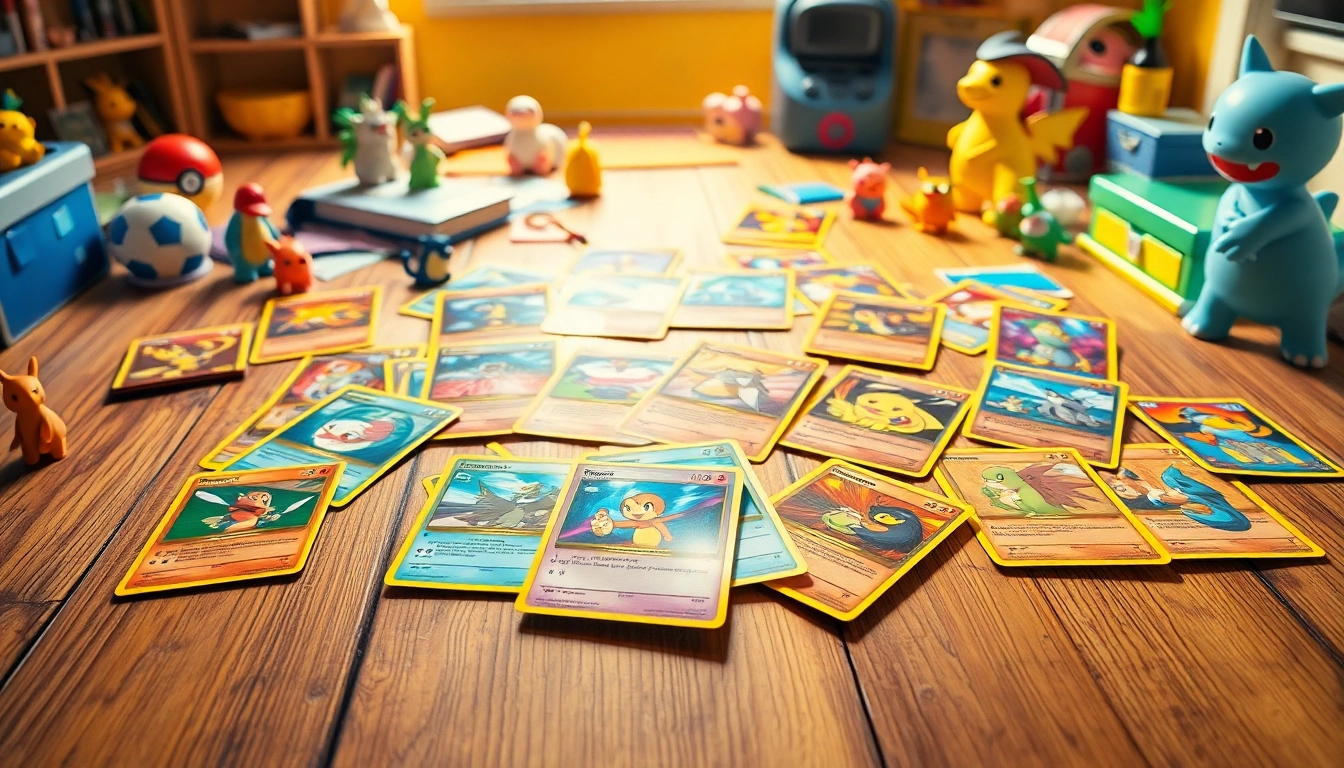Understanding Real Pokémon Cards
The world of Pokémon cards is vibrant and filled with an exciting blend of nostalgia, strategy, and collecting fervor. For enthusiasts and collectors alike, knowing the difference between real Pokémon cards and counterfeit ones is vital. Real Pokémon cards possess unique characteristics that not only validate their authenticity but also enhance their value within the trading card game (TCG) community. This guide aims to explore the intricacies of real Pokémon cards, providing insights into their authenticity, identification, purchasing channels, and best practices for preservation.
For those searching for real pokemon cards, having detailed knowledge is essential to ensuring that your investments are safe and genuine. Let’s dive into the fascinating aspects of these iconic cards.
What Makes Pokémon Cards Real?
Real Pokémon cards are produced by The Pokémon Company and are made from specific materials and processes that provide distinct characteristics. Here’s a breakdown of what sets real Pokémon cards apart:
- Printing Process: Genuine Pokémon cards are printed using high-quality techniques that ensure vibrant colors and clear details. Each card has a unique holographic pattern that is difficult to replicate accurately.
- Material Quality: Authentic Pokémon cards are made from a durable cardstock that feels different compared to cheap paper or plastic used in counterfeit cards. They possess a specific thickness and texture that collectors recognize.
- Card Back Design: A true Pokémon card has a distinctive design on the back, including the Pokémon logo and a specific arrangement of colors and patterns.
- Rarity Symbols: The rarity symbol, located near the bottom right corner of the card, indicates its value. Common cards typically have a circle, while rarer cards may have a star or other symbols.
The Importance of Authenticity in Collecting
For collectors, authenticity is paramount. Owning genuine cards not only enhances the quality of one’s collection but also maintains their investment value. Counterfeit cards can diminish the worth of a collection significantly and tarnish reputations. Moreover, authenticity fosters trust within the community. Marketers and collectors alike seek to engage in trades that assure them of the legitimacy of the cards involved.
Common Myths about Real Pokémon Cards
Several myths surround the realm of Pokémon cards, often misleading new collectors. Here are a few common misconceptions:
- All Rare Cards Are Valuable: Not every rare card brings significant value. Factors such as condition, demand, and collector interest play a major role.
- Shiny Cards Are Always Real: While many real cards feature holofoil, not all shiny cards are genuine. Always check for authentication.
- Old Cards Are Automatically Better: Age does not determine a card’s value. Often, the card’s condition and its significance in the game impact its worth more than its age.
How to Identify Real Pokémon Cards
Knowing how to identify real Pokémon cards is crucial for any collector wishing to avoid scams and counterfeit products. Here’s how you can verify authenticity:
Physical Characteristics to Check
When assessing a Pokémon card, pay close attention to the following physical characteristics:
- Light Test: Authentic cards allow light to pass through, revealing a blue core layer. Hold the card up to a bright light to confirm this.
- Card Thickness: Real cards have a specific thickness. Feel the card’s edge; if it feels too thin or flimsy, it might be fake.
- Weight: A real card has a certain weight due to its material. Weigh your card against a known authentic card for comparison.
- Print Quality: Inspect the printing quality; blurry edges, faded colors, or low-quality print are indicators of a fake card.
Using Technology to Verify Authenticity
With advancements in technology, verifying Pokémon card authenticity has become easier. Some methods include:
- Scanner or Mobile Apps: Use scanning apps designed to detect counterfeit cards. These apps can recognize patterns and barcode discrepancies.
- UV Light Test: Under UV light, authentic Pokémon cards reflect certain colors and have symbols visible only under such light.
- Digital Authentication Services: Utilize services that specialize in verifying card authenticity through expert analysis and grading.
Expert Tips for Spotting Fakes
Experts possess a wealth of knowledge when it comes to spotting counterfeit Pokémon cards. Here are some tips shared by seasoned collectors:
- Always purchase from reputable sources or known sellers in the community.
- Ask for images of the card’s front and back in high resolution. Pay attention to details that could reveal authenticity.
- Join collector forums or groups. Engaging with experienced collectors can provide valuable insights and assistance.
- Trust your instincts. If a deal feels too good to be true, it probably is. Be cautious and do your research.
Where to Buy Real Pokémon Cards Online
The availability of real Pokémon cards can vary by region and marketplace. Understanding where to buy authentic cards can save you time and money. Here are several trusted avenues to consider:
Top Trusted Websites for Purchasing
When looking for authentic Pokémon cards online, consider these reputable websites:
- Pokémon Official Store – Offering a wide selection of TCG products directly from the source.
- Cardmarket: Europe’s largest online marketplace for Pokémon cards, allowing users to buy and sell their collections safely.
- eBay: A popular site for trading card enthusiasts, but it is vital to check the seller’s ratings and reviews.
- Troll and Toad: A well-known trading card retailer offering both new and used Pokémon cards.
Understanding Pricing and Collector Value
Pricing for Pokémon cards can fluctuate based on several criteria:
- Card Condition: The condition (graded as mint, near mint, etc.) directly affects a card’s price.
- Rarity and Demand: The limited availability and collector interest in certain cards significantly impact pricing.
- Market Trends: Awareness of current trends, which can be influenced by factors such as tournaments or new expansions, will help you gauge value.
Marketplace Risks and How to Avoid Scams
Purchasing Pokémon cards online comes with risks. To protect yourself from scams:
- Verify the authenticity of the card before completing a transaction.
- Use secure payment methods that offer buyer protection.
- Read reviews and do background checks on sellers.
- Be cautious of unusually low prices, as they can indicate counterfeit products.
Storing and Protecting Your Real Pokémon Cards
Your collection deserves the best care to maintain its value and integrity. Here’s how to store and protect your real Pokémon cards:
Best Practices for Card Preservation
Preserving the condition of your cards is essential. Consider the following practices:
- Keep Cards Dry: Moisture can damage cards. Store them in a dry place away from high humidity.
- Avoid Direct Sunlight: Store cards away from direct sunlight to prevent fading or discoloration.
- Handle with Care: Avoid touching the card surface. Handle cards by the edges and consider wearing gloves.
Choosing the Right Sleeves and Binders
Using appropriate storage solutions can extend the life of your cards:
- Card Sleeves: Invest in high-quality, archival-grade sleeves to prevent scratches and moisture damage.
- Binders: Use binders with protective pages designed specifically for trading cards, ensuring they are acid-free.
- Storage Boxes: Utilize sturdy, protective boxes to store bulk cards safely and keep them organized.
Maintaining Value Through Proper Care
Taking proper care of your cards not only maintains their condition but also preserves their market value. Regularly check on your collection’s condition and make adjustments to storage as needed.
Connecting with the Pokémon Community
The Pokémon community is a vibrant and helpful place for collectors. Engaging with fellow enthusiasts can enhance your experience and knowledge base. Here’s how you can connect:
Joining Local and Online Collecting Groups
Consider joining communities where you can share your passion and learn from others:
- Local Game Stores: Participating in local events or game nights can be a good way to connect with other collectors.
- Online Forums and Social Media Groups: Platforms like Reddit (e.g., r/PokemonTCG) and specific Facebook groups are excellent places to discuss cards, share tips, and trade.
- Discord Servers: Many Pokémon card collectors are on Discord. Join servers dedicated to trading and discussing strategies in the Pokémon TCG scene.
Sharing Your Collection: Show and Tell!
Sharing your collection with others not only celebrates your achievements but also provides opportunities for feedback and advice. Social media, online forums, or community events can serve as platforms for you to showcase your rare finds, discuss strategies, and gain inspiration.
The Future of Real Pokémon Cards: Trends and Predictions
As the Pokémon franchise continues to evolve, the future of real Pokémon cards also looks promising. Several trends are emerging:
- Increased Digital Integration: The rise of digital card games may influence how physical cards are valued and collected.
- Sustainable Practices: There’s a growing demand for environmentally-friendly card manufacturing processes.
- Collector-focused Releases: More specialized and collector-focused card releases could emerge, catering to the expanding market of serious enthusiasts.
- Cross-Promotions with Other Media: Collaborations between Pokémon and popular culture could spark new interest and trends within the card game community.
In conclusion, navigating the world of real Pokémon cards requires knowledge, caution, and connection to the community. By understanding how to identify genuine cards, where to purchase them, and how to preserve your collection, you can enjoy the many rewards of this beloved pastime. Happy collecting!



